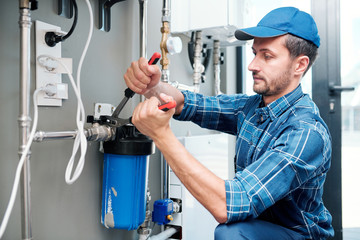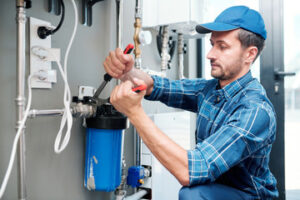Plumber Spring is responsible for installing and repairing pipes and fixtures in residential, commercial, and industrial buildings. They use specialized tools and interpret blueprints and building codes to plan plumbing projects and determine the best route for installing pipework and appliances.
Plumbers also interact with customers and must have excellent customer service skills. They often must explain complex plumbing concepts to customers and answer questions about their bills and plumbing needs.
Many homeowners think of testing their home’s water pressure when it starts to get low, but regular tests are just as important to ensure your plumbing systems are functioning properly. The only thing you need for a quick test is a simple pressure gauge, which can be picked up at any hardware or home improvement store. Look for one that has female hose threads, a rubber gasket to form a tight seal, and the ability to measure up to 300 pounds per square inch (psi). Before you begin, make sure all faucets, showerheads, dishwashers, washing machines, and refrigerator ice makers are turned off. Having all of these appliances off helps prevent water from moving throughout the system while you’re measuring pressure, which can throw off your results.
If you have a backflow prevention device in your home, it’s also necessary to have it tested annually. These devices stop dirty backflow from contaminating your clean drinking water supply, and they need to be properly installed and tested in order to function.
A plumber will shut off the water supply before starting the test, and they’ll ask you to sign a document that says you understand no one can use the water until testing is complete. They’ll then check the device visually and record its manufacturer, model number, size, and location. They’ll also connect the pressure test hoses to the downstream valve, wait a few minutes, and then hook up the gauge. If the pressure drops significantly, it means there is a problem with the device that needs to be repaired or replaced.
If the pressure stays high, it indicates the problem is somewhere else in the system, such as a leak. To pinpoint the source of the problem, a plumber will listen for bubbling or gurgling noises that indicate air is making its way into the leaky area. Once they’ve found the source of the problem, they can fix it and restore your home’s water pressure.
Leak Detection
Water pipe leaks are a common problem that can cause serious damage if not addressed quickly. A leaking water line can erode soil, void foundations, and compromise the integrity of buildings. In fact, the American Water Works Association estimates that the United States loses over 2 trillion gallons of water a year due to undetected leaks in existing infrastructure. The good news is that a plumber can find and repair these leaks with state-of-the-art equipment and tools.
One way is to use specialized acoustic leak detection. Acoustic leak detectors work by using high frequency sound waves to locate the source of the leak. The sound is picked up by a sensor and converted into decibel readings, which helps technicians pinpoint the exact location of the leak. This allows them to avoid expensive and unnecessary excavations and repairs.
Another popular method is to use flow meters and water loggers. These devices are used to measure and record water usage for residential and commercial properties. These devices can also detect abnormalities and help to identify potential problems. They can be installed at specific points (such as under sinks) or as whole-house systems.
There are several signs of a leak, including unexplained water puddles, unusually high water bills, and changes in your home’s humidity levels. Other symptoms include a foul smell, discolored water, or broken faucets and shower heads. If you notice any of these signs, it’s important to contact a plumber immediately to fix the problem.
Leak detection can save businesses significant amounts of money by allowing them to track the exact location of leaks in their pipes and structures. By minimizing the amount of materials that are lost, companies can significantly increase their profits and reduce operating expenses.
For example, a company that uses large amounts of chemicals to produce certain products may need to store and transport those materials in pipes. These products can contaminate the surrounding environment if they leak, and a leak detection system can monitor these pipes to ensure that no harmful materials are escaping.
Leak detection can help to prevent costly property damage as well as save energy and water in the home or business. For this reason, homeowners should regularly check their water meter and look for wet spots around the house to ensure that there are no hidden leaks. It’s also a good idea to inspect water fixtures, such as toilets, showerheads, and irrigation systems, to ensure that they are working properly.
Backflow Prevention
Water is pushed through your plumbing by pressure and is only supposed to flow in one direction. Sometimes backflow can occur, especially when there is a pressure change. If this happens, it could siphon contaminants such as fertilizers, soap, chlorine, human waste, or chemicals into city water lines. Backflow preventers are installed to keep this from happening. These devices are required by modern plumbing codes in areas where a backflow cross-connection exists. There are several different types of backflow prevention devices, but the most common is an air gap that creates a physical barrier between potable and non-potable systems. This type of device is easy enough for any plumber to install and can protect against both back siphonage and backpressure.
Most cities require backflow testing on a routine basis to ensure these preventers are working correctly. The testing process involves a technician connecting a special test kit to the backflow preventer and monitoring gauges for any changes in pressure. If there is a problem, the tester will notify you and the city, so repairs can be made.
Once the backflow test is complete, a report will be sent to the NYC Department of Environmental Protection (DEP). DEP reviews and approves these reports and sends a stamped copy to the property owner for their records. The testing is usually performed during the fall to avoid summer temperature fluctuations that could affect the results.
A backflow preventer can be tested by a certified tester or a licensed master plumber (LMP). An LMP can also repair or replace backflow preventers. Backflow testing is required on a regular basis, and failure to do so could result in fines or an interruption of your fresh water supply.
Most single-family homes do not need backflow testing, but commercial and industrial properties do have to have theirs tested by a certified backflow tester. The tests are important because they can help ensure the safety of your drinking water and could save you money. If you receive a notice that your backflow test is due, contact us right away to schedule an appointment with a local plumber.
Contact Us Today
In today’s fast-paced society, people place a lot of importance on products and services that make their lives more convenient. Plumbing is one such service, and if your home’s plumbing system is not functioning properly, it can cause problems in other areas of the house. Fortunately, a plumber can provide you with the necessary solutions to resolve any issues that may arise.
Plumbers are skilled tradesmen who install, repair and maintain pipes and fixtures that deliver water and drain waste in residential, commercial and industrial buildings. They use a variety of tools and equipment, including wrenches, pipe cutters, soldering devices, and diagnostic tools like leak detection technology and drain cameras. Plumbers also adhere to strict safety protocols when working in confined spaces or with hazardous materials.
Becoming a plumber is a rewarding career choice for individuals who enjoy working with their hands and providing essential services to their communities. There are several routes to becoming a plumber, including earning a certification through a vocational school or completing an apprenticeship. However, not all routes are suitable for every person. You should explore your options and find the right path for you.
A career as a plumber can be physically demanding and requires a lot of time on your feet. Additionally, plumbers often work evenings and weekends in response to emergency calls. This can disrupt your personal life, but it is a necessary part of the job. It is important to understand the demands of the career before making a commitment.
Some of the most common plumbing issues are caused by clogged or broken toilets and sewer lines. These issues can cause mushy or muddy sections of the yard, foul smells, and even waterborne diseases. If you notice any of these issues, contact a plumber immediately for assistance.
Plumbers must be licensed in their state in order to practice the profession. License requirements vary by state, but usually include a combination of classroom study and on-the-job training under the supervision of a master plumber. Depending on the jurisdiction, licenses may also require continuing education and skill development to remain current with changing industry practices and regulations.



 Many plumbing emergencies can’t wait until normal business hours, such as sewage system repairs, boiler repair, and mainline water break repairs. These types of problems can cause serious damage to your home and need immediate attention.
Many plumbing emergencies can’t wait until normal business hours, such as sewage system repairs, boiler repair, and mainline water break repairs. These types of problems can cause serious damage to your home and need immediate attention.